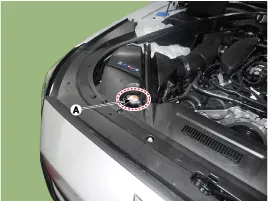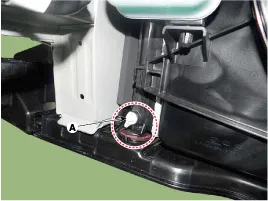Hyundai Genesis (DH): Cooling System / Coolant Repair procedures
Hyundai Genesis (DH) 2013-2016 Service Manual / Engine Mechanical System / Cooling System / Coolant Repair procedures
| Replacement and Air Bleeding |
Never remove the radiator cap when the engine is hot. A
serious scalding could be caused by high-pressure hot fluid escaping
from the radiator. |
When pouring engine coolant, be sure to shut the relay box
lid and not to let coolant spill on the electrical parts or the
paint. If any coolant spills, rinse it off immediately. |
| 1. |
Make sure the engine and radiator are cool to touch. |
| 2. |
Remove the radiator cap (A).
|
| 3. |
Loosen the drain plug (A), and drain the coolant with the radiator cap still being open for smooth draining.
|
| 4. |
Tighten the radiator drain plug securely. |
| 5. |
Remove, drain and reinstall the reservoir.
(Refer to Cooling System - "Reservoir Tank")
Fill the tank halfway to the F mark with water, then up to the F mark with antifreeze. |
| 6. |
Fill the radiator with water through the radiator cap and tighten the cap.
|
| 7. |
Start the engine and allow it to come to normal operating temperature. Wait for the cooling fans to turn on several times.
Accelerate the engine to aid in purging trapped air. Shut engine off. |
| 8. |
Wait until the engine is cool. |
| 9. |
Repeat steps 1 to 8 until the drained water runs clear. |
| 10. |
Fill fluid mixture with coolant and water (45~60%) (except
for North America, Europe and China : 45~50%) slowly through the
radiator cap.
Push the upper/lower hoses of the radiator so as to bleed air easily.
|




